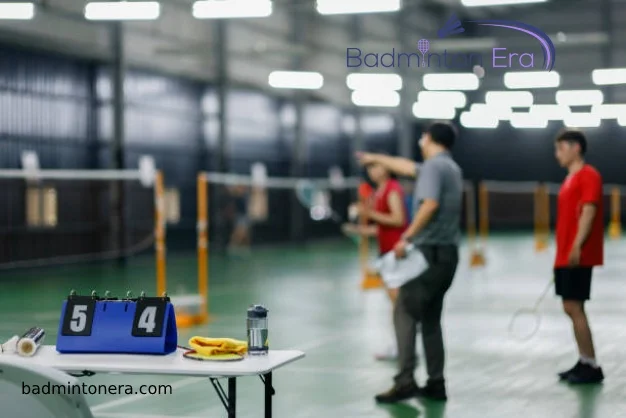3 Scoring System in Badminton
The scoring system in badminton is a crucial aspect that determines the outcome of a match. It adds an element of excitement and strategy to the game. In this article, we will explore the three scoring systems commonly used in badminton: the 21-point system, the 11-point system, and the 5×11-point system. Understanding these scoring systems will help players and enthusiasts follow and enjoy the game to its fullest.
Badminton Scoring System:
The scoring system in badminton for both singles and doubles matches follows a best-of-three-games format. To win a game, a team or player must reach 21 points first.
In badminton, a point is earned on every serve, and it is awarded to the side that wins the rally. The winning side then gets the opportunity to serve next.
In cases where the score is tied at 20-20, a team or player must gain a two-point advantage to win the game. If the score reaches 29-29, the first team or player to reach 30 points is declared the winner of the game.
Understanding the badminton scoring system ensures fair competition and adds excitement to the game as players strive to outscore their opponents while adhering to these rules.

How are points scored in Badminton?
In badminton, points are earned in two main ways: by successfully landing the shuttlecock inside the court on the opponent’s side, or when the opposing side commits a fault. The conclusion of a rally occurs when the shuttlecock touches the floor, and the point is awarded based on whether it landed within the boundaries of the court and on which side. To determine the winner of each point, the position and trajectory of the shuttlecock are crucial factors. Understanding the rules of inbounds and outbound plays a significant role in scoring accurately during a badminton match.
The Current Scoring System in Badminton:
In 2006, the Badminton World Federation (BWF) introduced a new scoring system, replacing the previous service-based scoring with rally point scoring. Under this system, a point is scored by either player/pair at the conclusion of every rally.
The current scoring system in badminton can be summarized as follows:
Game: The objective is to be the first to reach 21 points.
Match: Consists of the best of three games, with each game played to 21 points. Points: A point is awarded after each rally, regardless of the serving side.
Serving Rights: The side that wins the rally continues to serve or retains the right to serve.
20-20 Rule: If the score reaches 20-20, a setting occurs where a player/pair must gain a two-point lead to win the game. 29-29 Rule: In the event of a 29-29 tie, the side that scores the 30th point secures victory. Serve Rotation: The side that wins the game starts with the service in the next game.
The current scoring system, based on rally points, promotes continuous action and adds excitement to the game. It encourages players to stay competitive throughout each rally, as every point contributes to their overall score.

The 21-Point System:
The 21-point system is the traditional scoring system in badminton. In this system, players compete to reach 21 points first. Each rally results in a point being awarded to the winning player or team. Only the serving player or team can score a point. If the serving side wins the rally, they gain a point and continue to serve. If the receiving side wins the rally, they gain a point and take over the serve.
In the 21-point system, a game is typically played in a best-of-three format. This means that the first player or team to win two games is declared the overall winner. However, in some tournaments, including professional matches, the best-of-five format may be used for a higher level of competition.
The 11-Point System:
The 11-point system, also known as the “rally point system,” is an alternative scoring system that aims to make matches more fast-paced and engaging. The rules of scoring in the 11-point system are similar to the 21-point system, with a few notable differences.
In the 11-point system, the first player or team to reach 11 points wins the game. Unlike the 21-point system, points can be scored by both the serving and receiving sides. Additionally, there is no need for the serving side to win the rally to score a point. This scoring system creates a sense of urgency, as every rally contributes to the score, making matches more thrilling and unpredictable.
Similar to the 21-point system, games in the 11-point system are typically played in a best-of-three or best-of-five format, depending on the level of competition.
The 5×11-Point System:
The 5×11-point system, also known as the “BWF (Badminton World Federation) scoring system,” is the current standard for professional badminton matches. It was introduced to ensure consistency and streamline the game across all professional tournaments.
Under the 5×11-point system, the first player or team to reach 11 points wins a game. Similar to the 11-point system, points can be scored by both the serving and receiving sides. However, unlike the previous systems, matches are played in a best-of-five format, where the first player or team to win three games emerges as the winner.
This scoring system has been designed to increase the intensity and competitiveness of matches while allowing for more strategic play. It also ensures that matches do not become excessively long, making them more spectator-friendly.
Related FAQs:

Is serving required to score points in badminton?
No, serving is not a requirement to score points in badminton. In badminton’s rally point scoring system, a point is awarded after each rally, regardless of which player served.
How can you lose points in badminton?
Points can be lost in several ways in badminton. These include hitting the shuttlecock out of bounds, committing a fault during the service or rally, and the opponent successfully landing the shuttlecock on your side of the court.
If you found this article helpful, please consider sharing it with a friend. If you have any additional feedback, suggestions, or advice, please leave a comment below to help others. Thank you for reading.
Conclusion:
Understanding the scoring systems in badminton is essential for players and fans alike. The 21-point system, the 11-point system, and the 5×11-point system each offer a unique experience and set of rules. Whether you prefer the traditional 21-point system, the fast-paced 11-point system, or the professional 5×11-point system, each scoring system adds its own excitement and strategic elements to the game of badminton.







